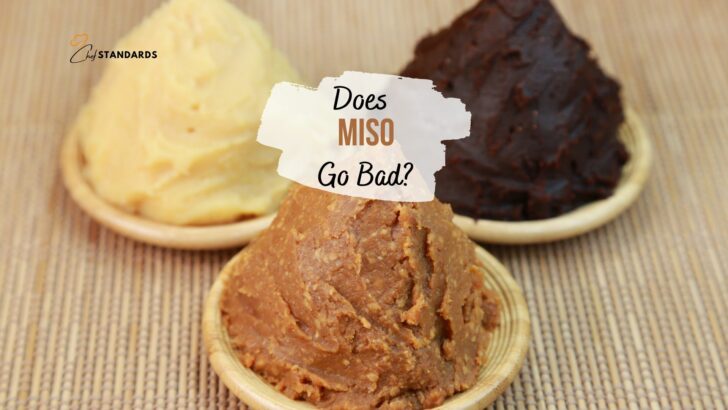Not many people are aware of the various incredible and delicious food products that Japanese cuisine offers. One of the classics is definitely miso-paste.
Whether you are making popular miso soup or some other Asian classic, like ramen noodles or miso butter, this ingredient can make it all.
But what if you have some miso in the pantry or fridge and you are not sure if it is still good since it has been sitting there for a while?
Does miso go bad? Like any other food product, miso can get spoiled in some cases, but the probability is quite low since it is actually a preservation ingredient.
But since there is a chance that spoilage happens, it is important to know some things, including spoilage signs, shelf life, and, most importantly, storage tips.
What is Miso Anyway?

Before I head to the main point, I will just say a few words about miso itself, so that you have a bigger picture about this product.
Miso is a paste and it is a traditional Japanese condiment that has been used in Japanese cuisine for centuries.
It is made through a process of fermenting soybeans, along with other ingredients like rice or barley, salt, and a specific type of mold called koji (Aspergillus oryzae).
The result is a thick, flavorful paste with a complex and savory taste known as umami. Miso paste is quite versatile and it is considered both a flavor enhancer and an ingredient base.
Since it has all those qualities, it is no surprise why people are concerned about its spoilage and shelf life.
Does Miso Really Go Bad?

As I already mentioned in the introduction, miso is a food and all foods and food products can go bad eventually. Miso paste is therefore no exception.
However, it is a different type of product since it is actually a preservative, meaning that it has a very long shelf life when stored the right way.
It lasts quite long, something similar to tahini, for example, and even longer.
The biggest factor that contributes to this is the fermentation process and preservation methods used during production.
Proper fermentation and preservation help to create a stable environment for miso, allowing it to last longer.
There is also its high salt content, which contributes to its long shelf life since salt also acts as a preservative by neutralizing a mixture that can contribute to spoilage.
However, I have to emphasize that there are some low-salt content types of processed varieties like those containing soup stock. You need to be more careful with them since they tend to spoil more easily.
Aside from that, bad packaging and especially bad storage conditions can contribute to potential spoilage, although that is quite rare. But since there is a chance, it is not out of hand to learn more about some spoilage signs.
What Are Some Red Flags To Be Aware Of?

As you already know, miso is a really shelf-stable ingredient and the chance that it will actually spoil is very low to none. However, there are some signs that can tell you that your miso isn’t very good anymore.
First, I have to emphasize that a change in its color is not always a bad sign. If you notice that your miso paste has become darker, know that it is a natural process known as the Maillard reaction.
As miso paste ages, the amino acids and sugars present in the soybeans, grains, and koji undergo this reaction, leading to the development of a darker color.
That only leads to a different, bolder flavor, but the important thing is that the miso is still safe to eat.
There is also enzymatic browning, which refers to the process where enzymes present in the miso paste, particularly those produced by the koji mold, interact with oxygen. This causes the natural browning similar to that of the fruits.
I have to say that this is also perfectly natural, so there is no room for worry.
However, the thing that can cause a bit of worry is the presence of mold. Fortunately, mold is not so common in miso, but it can sometimes develop on the surface if the storage conditions aren’t right.
In that case, all you have to do is to remove it from the surface and continue consuming the rest of the paste.
It is, however, a different story with miso products that have reduced sodium content as it can happen that mold grows inside, so it is important that you be very careful with these.
Finally, the taste and aroma can also change. You have to know that, again, the sour taste and aroma of miso develop over time as a result of the activities of lactic acid bacteria, which are naturally present in miso and contribute to its fermentation.
This is perfectly fine and, except for a different flavor, won’t cause any risks related to your health. However, if the taste and aroma are really off, it is best to avoid consuming it in order to stay on the safe side.
What is The Exact Shelf Life Of Miso?

Since it is a preservation product, miso paste can stay good for quite a long time. Unlike cream of tartar, store-bough miso will stay good for about 1 year.
I assume that you, just like many other people, are wondering about the expiration date. Well, I first have to say that the expiration date on the label is actually the “best-by date”, which indicates how long the product will retain its quality.
Considering that, you will still be able to consume it past that date, approximately about 3-6 months. It will still be safe after that time frame, but the chances are that the quality will not be the same anymore.
So, it is not recommended, but nothing significant will happen.
Once you open the packet, it is always best to put it in the fridge. Properly refrigerated, it will stay good for about 3 months. Once again, it will still be safe for consumption after that, but the flavor and texture won’t be the same.
How To Properly Handle And Store Miso?

The process of handling and storing food properly is always crucial, and miso is no exception.
If you have an unopened package of miso paste, all you have to do is to put it in a dark, dry place with a stable temperature and make sure that the lid is sealed tightly.
It is also important that the place where you store it is not exposed to direct sunlight or any other high-heat source. Namely, higher temperature accelerates the fermentation process, causing the paste to spoil more quickly.
Once you open the package, it is best to refrigerate the paste. Although you can put it in the fridge in its original packaging, my recommendation is to transfer it to an airtight container, especially if it came in miso packets.
Airtight packaging helps prevent air exposure and moisture absorption, which can lead to flavor degradation and spoilage. When you go through that process, make sure that the utensils are perfectly clean and that the container is tightly sealed.
You can also add an extra layer of protection in the form of plastic wrap in order to protect the paste from cross-contamination as it can easily absorb odors from other strong-smelling foods.
Is Freezing An Option?

Although I personally do not prefer it, freezing is an option. It will add some extra time to the shelf life of your miso paste, but nothing special really.
If you choose to freeze it, my advice is to avoid freezing it in its original packaging. It is much better to transfer it to a freezer bag.
Just make sure that you pull out all the excess air from the bag and seal it properly.
Finally, it is important that the temperature of the freezer doesn’t go beyond -5°F, as that can degrade the flavor and texture of the paste.
If you want to freeze small, individual portions of miso paste, it is best to use ice cube trays. Freezing miso paste in small portions is great if you’re using it as a beef bouillon substitute. You just have to cover them or use trays with lids in order to avoid contamination.


